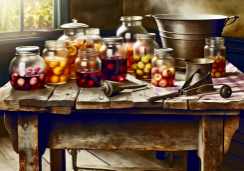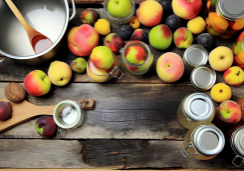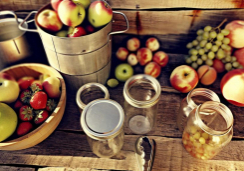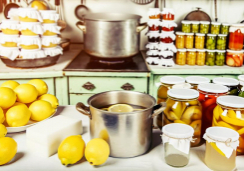Crafting the Ultimate Homemade Pizza Dough: A Journey
Just as Michelangelo saw the angel in the marble and carved until he set him free, you too embark on an artistic quest to liberate the perfect pizza from a humble mound of dough.
Your hands are the chisels, crafting not from stone but from flour, water, yeast, and salt—simple ingredients that demand your respect and precision.
You'll find that the journey to mastering homemade pizza dough is sprinkled with insights, from selecting quality ingredients to understanding the chemistry of fermentation.
As you hone your kneading technique and cultivate patience during the rise, remember that the path to the ultimate crust is as rewarding as the first bite of your creation.
But before you preheat your oven and dust the peel with semolina, let's explore the subtleties that transform good dough into great—the secrets that lie just beyond the next fold.
Selecting Quality Ingredients
When embarking on your homemade pizza dough journey, choosing top-notch ingredients is crucial for creating a crust that's both deliciously flavorful and satisfyingly textured. You'll want to start with the right type of flour. While all-purpose flour can work, selecting bread flour gives your crust that coveted chewy texture and robust structure. It's the gluten strength in bread flour that provides that distinctive bite, setting your homemade creation apart from lackluster crusts.
Next, let's talk about yeast, the magical element that breathes life into your dough. Freshness is key, so check those expiration dates. Instant yeast offers convenience and reliability, integrating effortlessly with your flour and warm water. Active dry yeast, while slightly more traditional, needs a bit of proofing but still promises a beautiful rise.
Don't just splash in any water; warm water activates your yeast, coaxing out its full potential. As for olive oil, reach for a high-quality bottle. This isn't just about avoiding saturated fat; it's about infusing your dough with a rich, savory note that'll make each bite a sensory delight. Finally, season your dough with sea salt for that perfect flavor balance. If you're feeling adventurous, a pinch of Italian seasoning can add an aromatic twist.
Mastering the Kneading Technique
Having selected the finest ingredients for your pizza dough, it's now time to roll up your sleeves and get hands-on with the art of kneading, a technique that's crucial for achieving the perfect texture and elasticity in your crust.
Begin by combining your active dry yeast with the yeast mixture according to the recipe, ensuring it's foamy and active. Then, mix it into your flour mixture to form a shaggy dough.
Here are a few tips to make your kneading process more effective:
- Consistency is Key: Knead for a solid 6 minutes. This isn't just a workout for your arms—it's essential for developing that gluten network that gives the dough its stretch and chew.
- Technique Matters: Place the dough ball on a clean surface. Use the heel of your hand to push the dough away from you, then fold it back over itself. This rhythmical motion isn't just therapeutic; it evenly distributes ingredients and air, creating a smooth, pillowy dough.
- Test Your Texture: After kneading, test the dough by giving it a gentle poke. If it springs back, it's ready to let it rise. Place it in a bowl, cover it, and wait patiently for the rise time to work its magic.
If you have a stand mixer, you can use a dough hook attachment for kneading—but there's something truly satisfying about doing it by hand. Remember, don't over-flour your surface, or you risk a tough crust.
Happy kneading!
Perfecting Dough Fermentation
Embarking on the fermentation stage, you'll unlock the full potential of your pizza dough, allowing it to develop rich flavors and an irresistible, airy texture. This pivotal moment transforms your mixture of dry ingredients into what'll become the best pizza dough you've ever tasted.
To begin, ensure that your dough is covered with plastic wrap to prevent it from drying out. Yeast requires a warm, moist environment to thrive; therefore, place the dough in a cozy spot where it can rise undisturbed. The length of time you let the dough sit is a game-changer. Too short, and you'll miss out on depth of flavor; too long, and the dough may overproof, leading to a denser Homemade Pizza Crust.
As you watch the dough slowly expand, you're witnessing the magic of fermentation. It's not just about letting it grow; it's about allowing flavors to mature, which only time can achieve. After several hours, or even overnight, your dough should exhibit signs of perfect fermentation: a noticeable increase in size and a slightly elastic texture that promises a sublime bite.
Mastering this recipe step ensures your pizza will boast a crust that's the envy of connoisseurs and casual diners alike. Let the dough rise, and with it, your home chef reputation.
Shaping the Pizza Base
Shaping your pizza dough is a craft where precision meets artistry, a pivotal step that sets the stage for a crisp yet tender crust. After perfecting fermentation, it's time to transform your homemade pizza dough into the foundation of your culinary masterpiece.
Here's how to shape your pizza base with finesse:
- Divide and Conquer: After the dough has rested, split it into two. Work each piece on a lightly floured surface to prevent sticking. This division allows for more manageable shaping and yields two pizzas with an evenly cooked, crispy crust.
- Roll with It: Gently Roll the dough from the center outwards, rotating it to maintain a circular shape. If you're feeling adventurous, try stretching or flipping the dough by hand.
- Prepare for the Oven: Lay the shaped dough onto a pizza stone, pizza pan, or parchment paper-lined tray. Ensure it's positioned well to avoid any misshapen disasters once it's laden with toppings.
Baking for Optimal Crust
Once your pizza base is skillfully shaped, it's time to focus on achieving the perfect crust by mastering the baking process. Slide your creation into a preheated oven, the sanctuary where your easy pizza dough will transform into a culinary masterpiece.
Ensure that your oven is as HOT as it can safely go—usually around 475 to 500 degrees Fahrenheit. This intense heat works wonders, creating a crispier crust that's the hallmark of a great pie.
If you're aiming for that pizzeria-quality thin crust, consider using a cast iron skillet or a pizza stone. These retain high heat and distribute it evenly, mimicking the conditions of a commercial pizza oven.
For a thick crust that's fluffy and soft on the inside but golden and crunchy on the outside, a lower temperature around 400 degrees Fahrenheit might suit better, coupled with a slightly longer baking time.
Frequently Asked Questions
What Is the Secret to Great Homemade Pizza Dough?
You'll master homemade pizza dough by balancing hydration levels, perfecting your kneading technique, and patiently observing resting periods. Control temperature, ensure dough elasticity, optimize fermentation time, check yeast freshness, adjust salt ratio, and consider oil addition.
What Is the Best Flour for Pizza Dough?
The best flour for pizza dough depends on your texture preference. Bread flour's high protein strengthens gluten for elasticity, while finely milled tipo 00 offers a lighter crust. Organic, unbleached options enhance flavor.
Should I Prebake Homemade Pizza Dough?
Yes, you should prebake your pizza dough to enhance dough elasticity, prevent sogginess, and ensure cheese melting perfection. Proper kneading, resting time, and baking temperatures are vital for that ideal edge puffiness.
How to Make Homemade Pizza Dough More Flavorful?
You'll boost your pizza dough's flavor by experimenting with yeast selection, adjusting water temperature, and trying various salt varieties. Mix in olive oil, sugar, or fresh herbs, and let fermentation work its magic.
Conclusion
You've journeyed through the art of pizza dough, selecting fine ingredients and mastering the knead. Your dough has risen, full of promise.
Shaped into a canvas, it's ready for your culinary creativity. Slide it into the oven and watch as it transforms into a golden, crispy crust—the ultimate base for your topping masterpiece.
Relish the satisfaction of homemade perfection. Every slice you savor is a testament to your dedication.
Bon appétit, pizza artisan!










